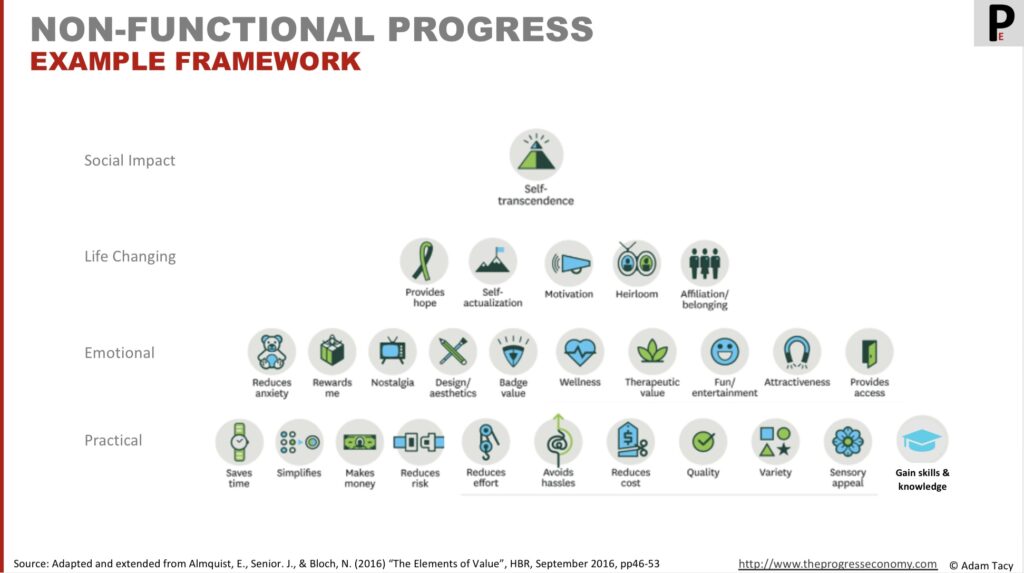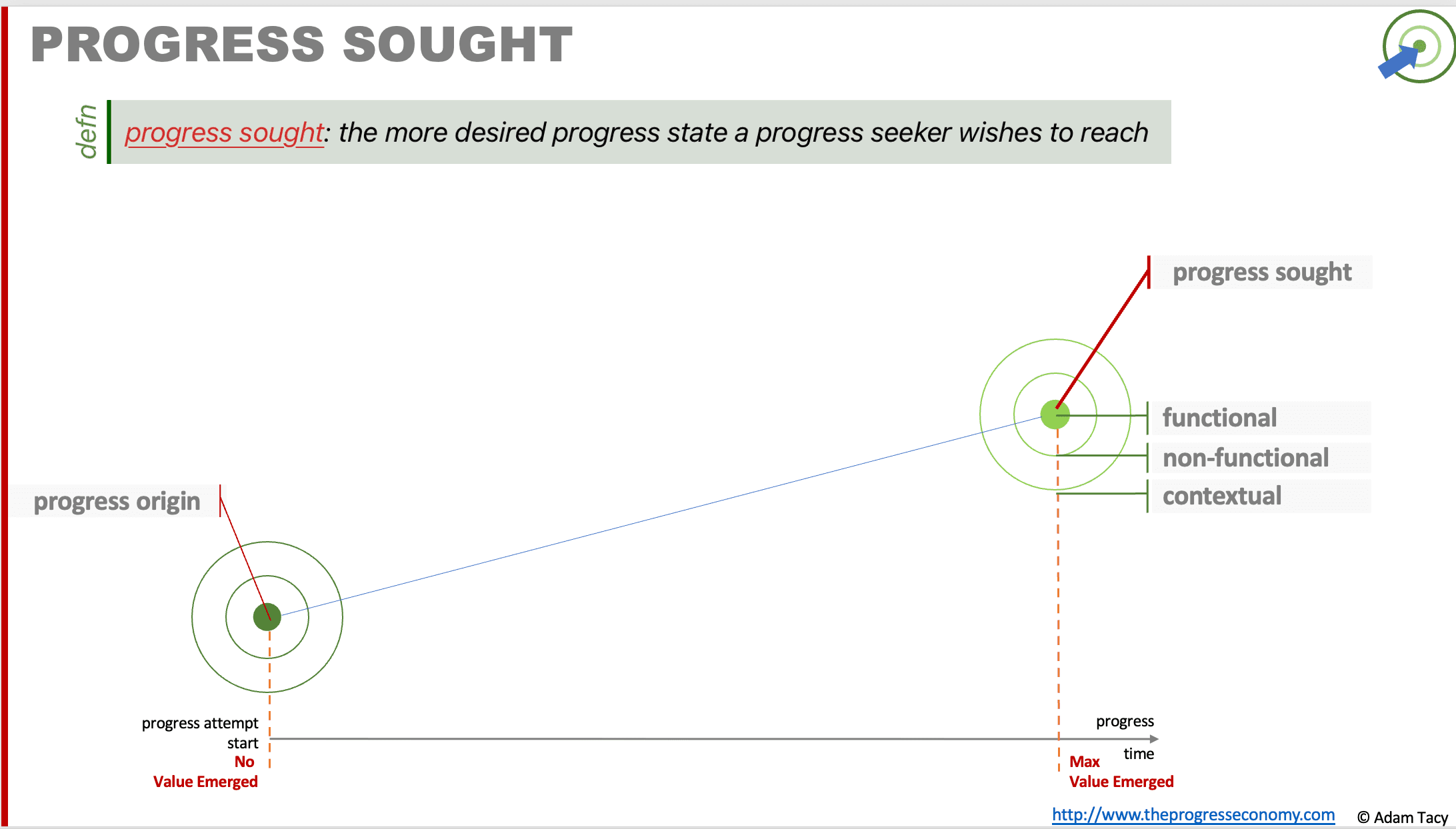Writing / Editing below here
Identifying progress sought
Sadly, or perhaps welcomingly, there are no shortcuts to discovering seekers’ progress sought. It is methodical process of discovery through, for example:
- Careful Observation
- Interviews
- Engagement with Seekers
Frameworks like design thinking and “jobs to be done” theories by Chistensen and Ulwick offer useful processes for this purpose.
Even when it feels like inspiration for progress sought strikes, we should develop that inspiration methodically to fully understand all elements of progress sought (functional, non-functional, and contextual).
In more formal scenarios, seekers may issue requests for information, quotes, or proposals (RFI, RFQ, RFP). Those capture the output of an organisation’s internal process to identify their progress sought. Nevertheless, these documents typically benefit from follow-up discussions to refine and enhance.
And sometimes, progress sought can be the act of refining and clarifying end user progress sought. The Agile or Lean approaches are examples. Here a seeker has a woolly idea of end user progress sought and sets out to refine and clarify that as part of their progress-making activities.
We also find that every time a seeker engages with a progress proposition is an opportunity to deepen understanding of seekers’ progress sought.
While no shortcuts exist, we can consider some general guidelines:
- focussing on progress not product
- uncovering the broader view
- getting abstract
- observing latent progress sought
- harnessing frameworks
- handling externalities
Let’s look into those.
Focussing on progress not product
A key mindshift is to prioritise progress over products, as famously exemplified by Levitt’s insight:
People don’t want to buy a quarter-inch drill. They want a quarter-inch hole!
Levitt, as quoted in Christensen’s 2006 article “What Customers Want from Your Products”
Focussing solely on the product – the drill, for example – we fall into Levitt’s marketing myopia trap. We get blinkered and fixate on making better drills. Whilst there is space for such innovation, that space is constrained. And we’re running out of it, limiting growth. How many more razor blades, for example, can Gillette add to their shaving products.
Levitt’s work carries a profound lesson. He explored how the US Railroads declined due to them being myopic. They saw their customers’ progress sought in terms of what they had: “transportation by rail”. By ignoring the true progress sought of “transportation over a distance” they missed out on air transportation. As a result, they nearly disappeared as viable businesses.
History abounds with examples of companies that became obsolete by fixating on their products rather than embracing progress: Kodak, Nokia, and Blockbuster, to name a few.
Shifting to progress-centric thinking – the hole – encourages exploration of a wider solution space. This goes hand-in-hand with our next point: uncovering the broader view.
Uncovering the broader view
Whilst functional progress is often the easiest to identify, we need to identify all elements of progress sought.

Understanding the non-functional and contextual aspects of progress sought provides valuable insights into a seeker’s objectives. This knowledge allows us to better identify potential resource gaps and to build offerings they really feel able to engage.
Let’s go back to drills. They clearly meet a functional progress sought of creating a hole. And we assume the seeker is comfortable with the drilling process, knows what the drill can drill into. What does considering non-functional and contextual progress sought add?
Well, non-functionally, we’re assuming the seeker has no anxiety about encountering hidden electric cables or pipes nor accidentally causing damage. We believe they appreciate the flexibility to use the drill when they want (not being held-up), are not overly focused on having the latest technology, are undeterred by the price, and acknowledge that the drill might be unused most of the time.
Additionally, we assume the seeker has the necessary time to make the hole, and there see no other constraints (such as how to handle drilling into a hazardous substance).
For sure, we’ll find seekers that match, or who attempting progress if there are no other options.
However taking a broader view of progress sought suggests other propositions might be better. Can we address anxiety issues, lack of time and/or skills and knowledge, access to latest technology, feelings of wasted resources, etc?. Offerings such as rental services, sharing platforms, inventing new tools to make holes, providing “hole as a service” where a handyman takes care of it, or even establishing locations at DIY stores for hole-making, all become more obvious.
OK, we might be running away with ourselves regarding making a hole, but I hope you see the point.
Getting abstract
Closely tied to Levitt’s observation on marketing myopia is needing to get the right level of abstraction for progress sought. This allows room for innovative progress offerings. Failing to do so might lead to shortsighted solutions.
For instance, if we identify some particular progress sought as ‘traveling 30km to the office by car’, we risk focusing innovation efforts to cars and related infrastructure.
A better abstraction is “travelling 30km to the office”. Opening up more offerings as solutions. Even better is to understand if “travel” can be abstracted. Perhaps the need to travel is related to meeting colleagues. Reframing progress sought as “Meet with colleagues who are 30km away” opens up virtual meetings, attending via virtual reality etc.
Of course, contextual element of progress sought might reflect constraints such as “in person” which potentially narrow the solutions. Which emphasises the need to understand all elements of progress sought. But we should always challenge constraints. Medical surgery, until recently, had a clear constraint of patient and surgeon being in the same location. Even that is being reduced through instances of telesurgery.
Observing latent and incipient progress sought
Marketers traditionally see customers as having existing, latent and incipient needs, usually defined as follows:
- existing – the need is known and there is an existing solution
- latent – the need is known but there is no existing solution
- incipient – the customer doesn’t (yet) know they have a need
Often incipient and latent needs are grouped together as latent needs which is dangerous from an innovation perspective. Meeting latent needs can be seen as helping a seeker reach nearer their progress sought. Sustainability may be seen as a latent, and growing, need.
Whereas meeting incipient needs is helping a seeker reach somewhere they didn’t know they wanted to each. It opens an exciting world. The “if you build it, they will come” view; a true field of dreams.
People will point to Apple as experts in this – iPodand iPhonebeing two successes. Perhaps Apple Vision will be the next. Google glass can be seen as a failure. And it’s this “perhaps” that is the danger for incipient needs. We’re imagining a desirable state that a seeker may want…but they may also not want. In chasing them we will expend effort that might be a fun journey but ultimately a waste of resources. But that’s a conversation best taken about progress offered.
Discovering the progress a seeker is looking to make is a substantial topic; there are some frameworks that can help.
Harnessing frameworks
When we looked at functional progress as part of progress as a state, we touched on Lovelock & Wirtz framework for categorising service (see here). This is useful for framing functional progress in our minds.
| processing category | description |
|---|---|
| people | progress related to individuals’ bodies, such as achieving physical fitness, enhancing appearance, improving health (medical services), and more. |
| possession | progress concerning individuals’ possessions, encompassing activities like transporting, recycling, storing, selling, renting, maintaining, fixing, and DIY tasks. |
| mental stimulus | progress involving individuals’ minds, which includes teaching, training, attending theatrical performances, and engaging with content like streaming services, podcasts, and Netflix. |
| information | progress tied to intangible resources, such as word processing, using virtual assistants, leveraging generative AI, and banking services. |
Similarly, a repurposed framework from Almquist’s article, “The Elements of Value,” assists in considering non-functional progress (see here).

Let’s also remember it’s not just progress seekers that define progress sought. We often have to understand externalities.

Let’s progress together through discussion…